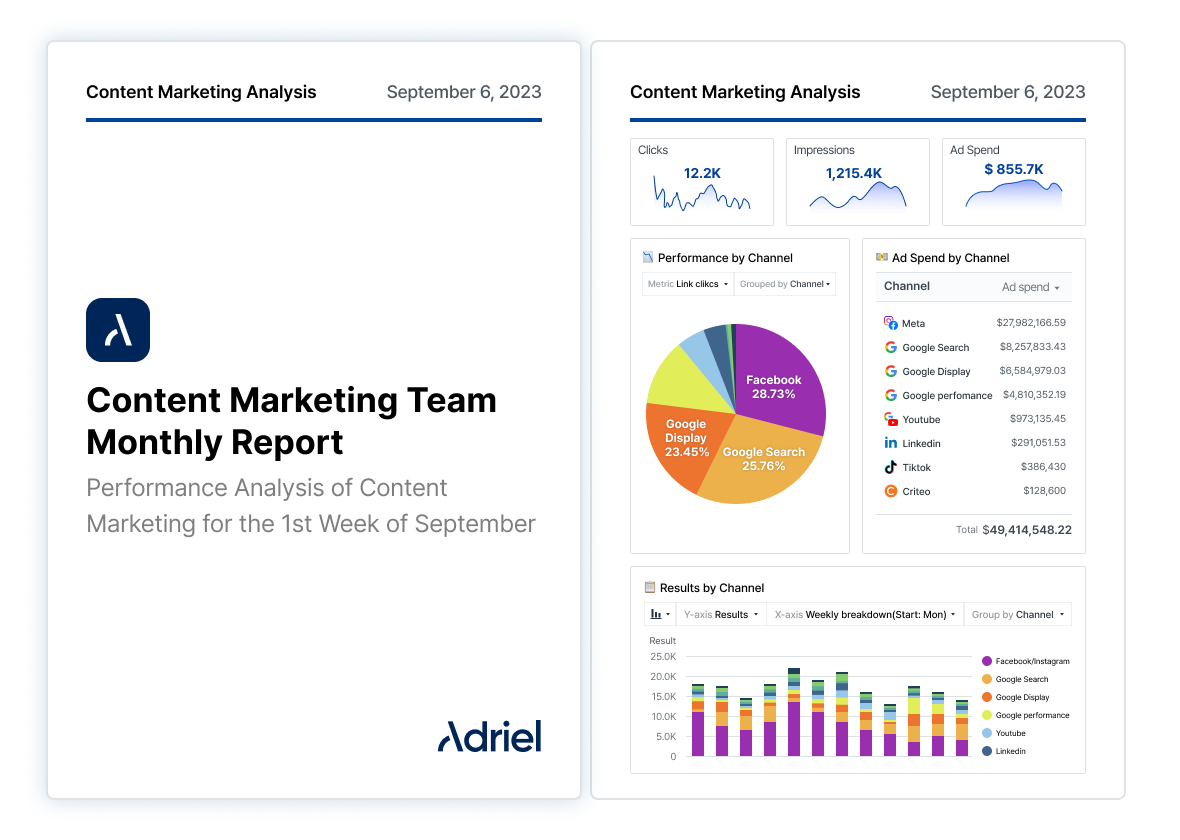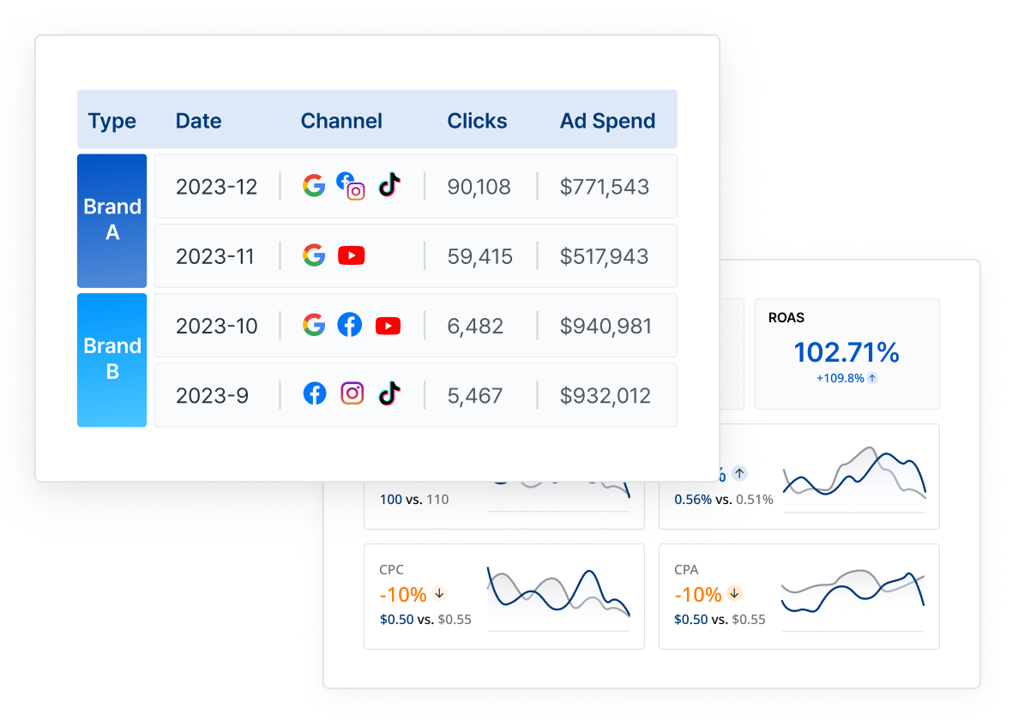Refer a partner and get paid! Earn 20% of all qualifying subscriptions referred to our team 👉

Learn More
Never waste money on flopping ads again. Optimize ad spend with a small business dashboard. Get critical insights for growth on one dashboard.



A small business dashboard is a marketing analytics tool that aggregates data from different sources and represents them using visual elements like charts, tables, and graphs.
By presenting business data in a visually appealing and understandable way, business dashboards help you understand your key performance indicators (KPIs) at a glance, enabling you to make data-driven decisions that improve your revenue.
On Adriel’s small business dashboard, you can see an overview of marketing performance at a glance, set real-time campaign alarms, and download a whitelabeled marketing report with just one click. You’ll also be able to analyze ad creative details and performance trends by channel and demographics.
Creating a small to medium business dashboard is as easy as 1-2-3 with Adriel. Just connect your ad accounts and marketing channels from a drop-down menu and your data will start flowing onto the dashboard automatically. No coding or technical knowledge required.

Sign up for Adriel with your email after your demo.
You can then select a pricing plan that suits your needs.

Simply choose from a drop-down list to import dimensions and metrics from your client’s ad accounts, analytics tools, and mobile measurement partners.
Adriel supports integrations with up to 650+ data sources, including social media channels, ad platforms, analytics tools, and eCommerce platforms.
And if you don’t see an integration that we support natively, we can create custom integrations just for you.

Use our ready-made templates to instantly see all your KPIs in minutes.
Or, start from a blank page and choose your data visualization widgets and graph types.

Set up different views for each account manager or client in just a few clicks. Give different access permissions and collaborate with others on a live dashboard.

Automate your entire client reporting process. Determine your clients’ brand visuals, colors, and logos, and download fully customized reports as PDFs or CSVs. Or share links to the live dashboard with clients.
Small business dashboards should visualize these important metrics:




Ad revenue is the income generated from your ad campaigns. It is a critical KPI for assessing the profitability and return of your advertising efforts.
ROAS evaluates the revenue earned for every dollar spent on advertising, crucial for determining the financial success of your ad investments.


Impressions count how often your ad is displayed, reflecting the reach of your campaign. Tracking impressions helps gauge brand awareness and the frequency of ad exposure to your audience.


Ad Spend tracks the total expenditure on your advertising campaigns. Monitoring this helps in maintaining budget control and calculating the cost-effectiveness of your ads.
CPC measures the cost for each click on your ad. This metric is crucial for managing the budget and optimizing the cost-efficiency of your ad spend.
CTR measures the effectiveness of an ad by the percentage of viewers who click on it, indicating how compelling your ad is to your audience.
Link clicks are the number of times users have clicked on a link within your ad. They signify user interest and are essential for understanding which content drives interaction.


The conversion rate indicates the percentage of visitors who complete a desired action, like a purchase, sign-up, or download. It's a direct measure of your campaign's success in motivating users to take action.




When reporting Meta Ads, you will want to visualize Instagram Ads and Facebook Ads performance side-by-side to understand how each platform is contributing to your digital marketing goals. Here’s how it looks like on Adriel’s report template:





Integrate all your paid ad channels’ results into one marketing reporting dashboard. Curious to know how your Meta, Google, or TikTok Ads are performing? Connect all of these platforms to Adriel, and in less than 5 minutes, show all of your paid campaign results in one unified dashboard. See our integrations page for more information.


Our software was expertly designed with powerful functions for marketers. But everything can be customized. Adriel’s flexibility allows you to change all aspects of the dashboard design and appearance. Impress your clients with a professional marketing reporting dashboard report for an expert brand image.
You can start from a blank page to create a marketing reporting dashboard, but what if you don’t have time? Our extensive pre-made marketing reporting dashboard library has everything you might need. Try Adriel, and you’ll have more time to research ways to increase conversion or optimize your landing pages.













.png)

If you're a small business looking for a marketing or reporting dashboard, we recommend you choose a tool that has these features:

For small businesses, compiling and analyzing complex data from marketing campaigns can be overwhelming.
A small business owner needs a dashboard that is not only data-rich but also user-friendly, helping them to spot trends, track performance, and make informed decisions. A platform like Adriel, with its real-time, interactive dashboard and extensive library of pre-built templates, is a prime example of this.
Adriel's Features for Small Businesses:
Other notable dashboard software for a small to medium sized company includes DashThis, Google Data Studio (Looker Studio), Whatagraph, and AgencyAnalytics. Each offers unique features like custom KPIs, extensive data connectors, real-time dashboards, and various pricing models to suit the needs of smaller businesses and their specific marketing campaigns.
By focusing on user-friendly interfaces, extensive data connectors, and real-time, interactive dashboards, these platforms help small businesses make data-driven decisions to enhance their marketing efforts and overall business performance.

Here are the metrics we recommend you track on your small business dashboard to better understand advertising performance, allocate budgets efficiently, and maximize returns on investment:

For small businesses aiming to expand their reach and revenue, it’s important to be present on the right marketing channels.
Here are several key channels that small businesses should consider being present on to drive growth:
You can then connect these channels onto a small business dashboard like Adriel. We support over 650+ integrations with all major (and minor) advertising and marketing channels.
If you use an incredibly niche channel and you can’t see a native integration, just reach out to us and we’ll build it for you.